Analyzing ECEC: A Comparison of Early Education in Australia & Korea
VerifiedAdded on 2023/06/04
|7
|1369
|137
Essay
AI Summary
This essay explores the significance of Early Childhood Education and Care (ECEC) by comparing practices in Australia and Korea. It highlights the different administrative structures, monitoring systems, and frameworks used in each country. In Korea, ECEC administration is divided between the Ministry of Health and Welfare and the Ministry of Education, leading to a complex system. Australia, on the other hand, emphasizes pre-primary education with a low teacher-to-child ratio and utilizes frameworks like the Early Years Learning Framework. The essay concludes that while both countries recognize the importance of early education, Australia has a more clarified approach to managing educational programs. The importance of early education has been proven by many studies as the developing mind learns things more easily and the storage memory of children at an early stage is very high. The results of the ECEC have proven to be very beneficial for the children that have been evaluated through the regular assessment of the staff service, quality and the development of the children.
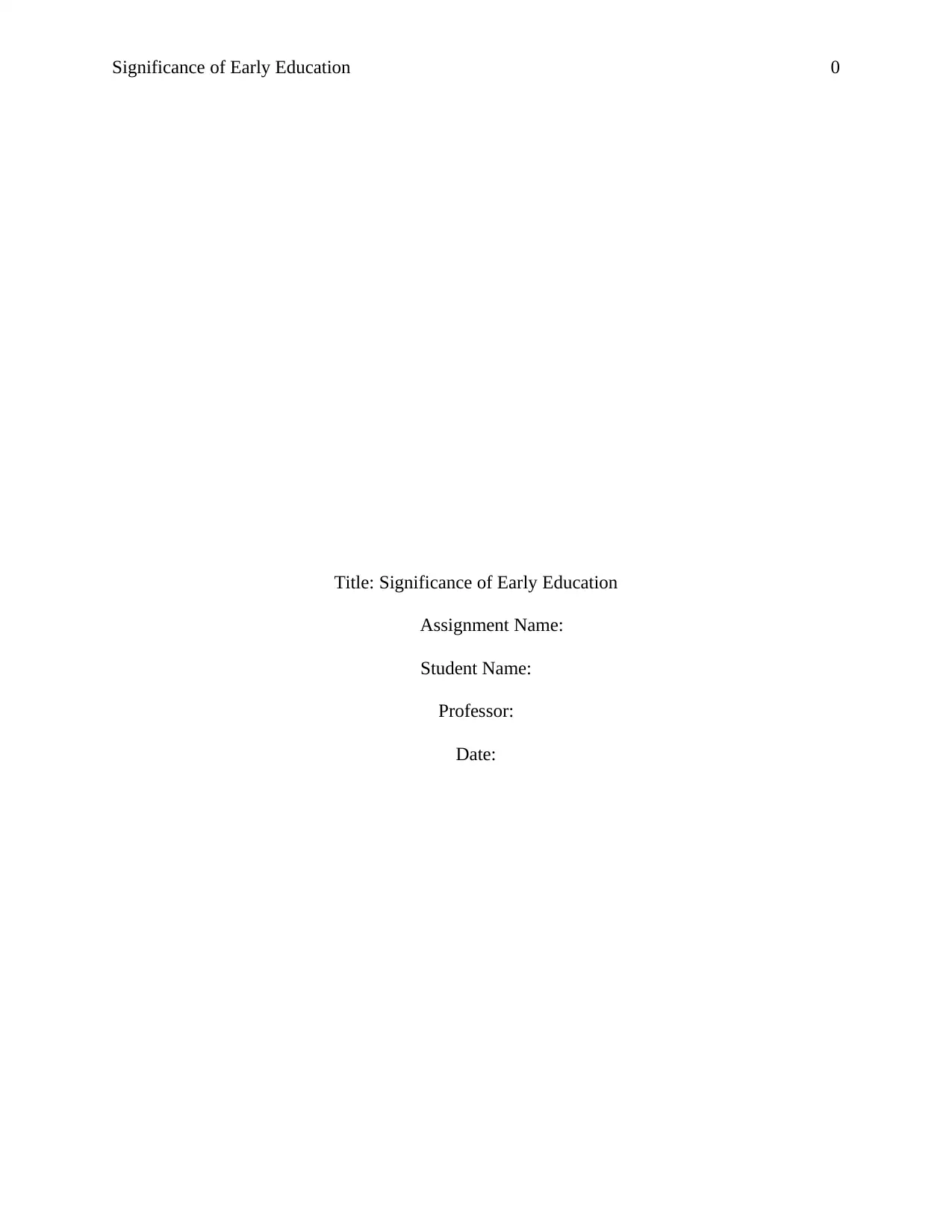
Significance of Early Education 0
Title: Significance of Early Education
Assignment Name:
Student Name:
Professor:
Date:
Title: Significance of Early Education
Assignment Name:
Student Name:
Professor:
Date:
Paraphrase This Document
Need a fresh take? Get an instant paraphrase of this document with our AI Paraphraser
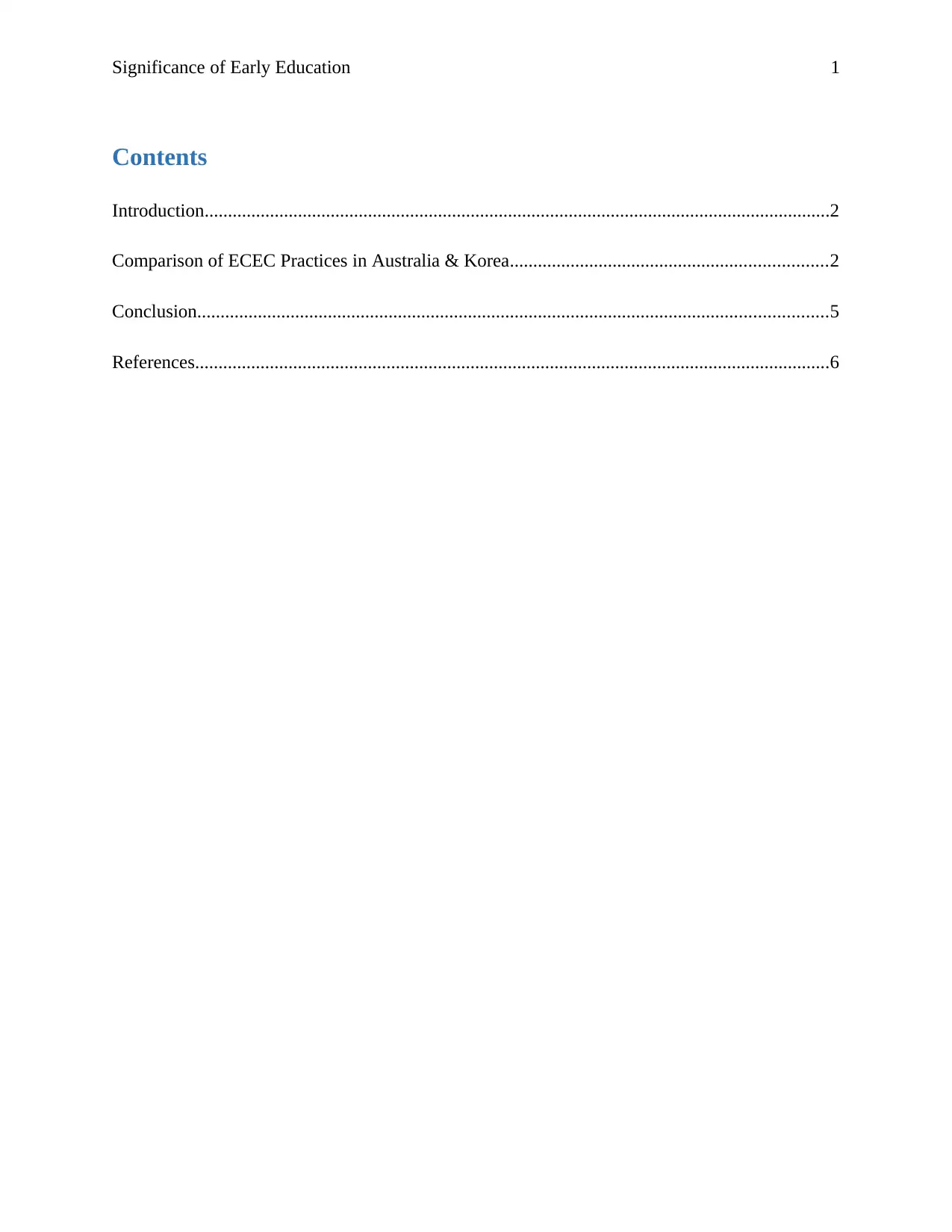
Significance of Early Education 1
Contents
Introduction......................................................................................................................................2
Comparison of ECEC Practices in Australia & Korea....................................................................2
Conclusion.......................................................................................................................................5
References........................................................................................................................................6
Contents
Introduction......................................................................................................................................2
Comparison of ECEC Practices in Australia & Korea....................................................................2
Conclusion.......................................................................................................................................5
References........................................................................................................................................6
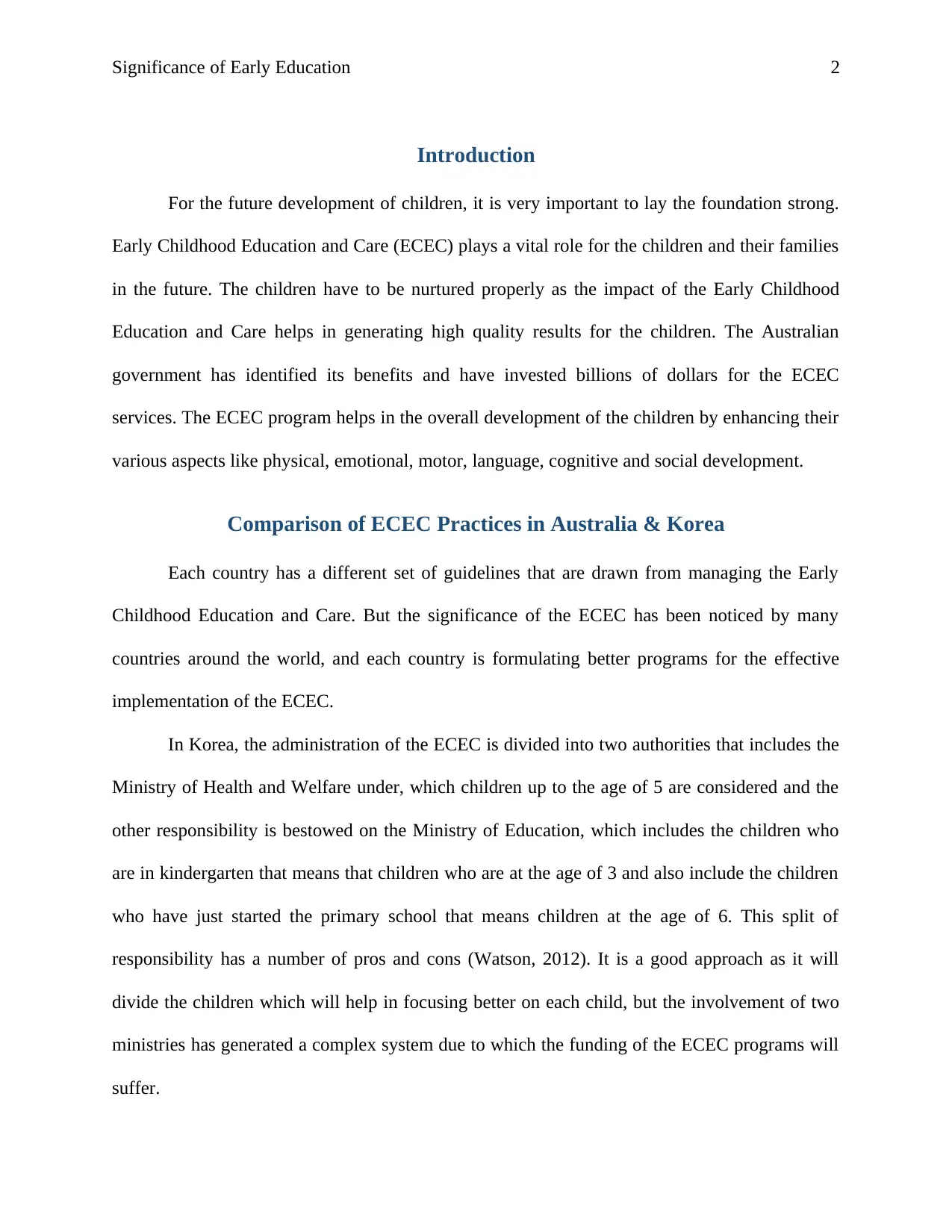
Significance of Early Education 2
Introduction
For the future development of children, it is very important to lay the foundation strong.
Early Childhood Education and Care (ECEC) plays a vital role for the children and their families
in the future. The children have to be nurtured properly as the impact of the Early Childhood
Education and Care helps in generating high quality results for the children. The Australian
government has identified its benefits and have invested billions of dollars for the ECEC
services. The ECEC program helps in the overall development of the children by enhancing their
various aspects like physical, emotional, motor, language, cognitive and social development.
Comparison of ECEC Practices in Australia & Korea
Each country has a different set of guidelines that are drawn from managing the Early
Childhood Education and Care. But the significance of the ECEC has been noticed by many
countries around the world, and each country is formulating better programs for the effective
implementation of the ECEC.
In Korea, the administration of the ECEC is divided into two authorities that includes the
Ministry of Health and Welfare under, which children up to the age of 5 are considered and the
other responsibility is bestowed on the Ministry of Education, which includes the children who
are in kindergarten that means that children who are at the age of 3 and also include the children
who have just started the primary school that means children at the age of 6. This split of
responsibility has a number of pros and cons (Watson, 2012). It is a good approach as it will
divide the children which will help in focusing better on each child, but the involvement of two
ministries has generated a complex system due to which the funding of the ECEC programs will
suffer.
Introduction
For the future development of children, it is very important to lay the foundation strong.
Early Childhood Education and Care (ECEC) plays a vital role for the children and their families
in the future. The children have to be nurtured properly as the impact of the Early Childhood
Education and Care helps in generating high quality results for the children. The Australian
government has identified its benefits and have invested billions of dollars for the ECEC
services. The ECEC program helps in the overall development of the children by enhancing their
various aspects like physical, emotional, motor, language, cognitive and social development.
Comparison of ECEC Practices in Australia & Korea
Each country has a different set of guidelines that are drawn from managing the Early
Childhood Education and Care. But the significance of the ECEC has been noticed by many
countries around the world, and each country is formulating better programs for the effective
implementation of the ECEC.
In Korea, the administration of the ECEC is divided into two authorities that includes the
Ministry of Health and Welfare under, which children up to the age of 5 are considered and the
other responsibility is bestowed on the Ministry of Education, which includes the children who
are in kindergarten that means that children who are at the age of 3 and also include the children
who have just started the primary school that means children at the age of 6. This split of
responsibility has a number of pros and cons (Watson, 2012). It is a good approach as it will
divide the children which will help in focusing better on each child, but the involvement of two
ministries has generated a complex system due to which the funding of the ECEC programs will
suffer.
⊘ This is a preview!⊘
Do you want full access?
Subscribe today to unlock all pages.

Trusted by 1+ million students worldwide
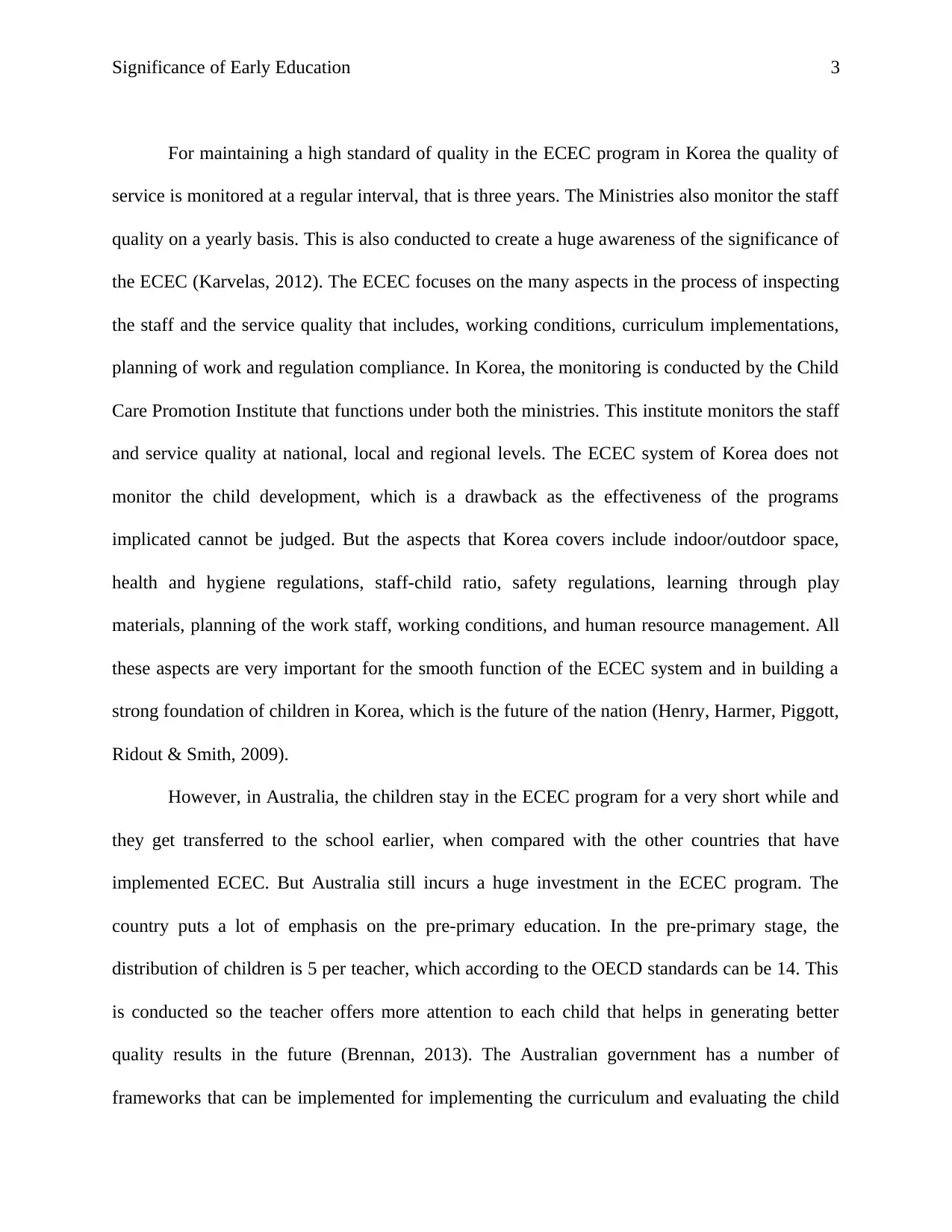
Significance of Early Education 3
For maintaining a high standard of quality in the ECEC program in Korea the quality of
service is monitored at a regular interval, that is three years. The Ministries also monitor the staff
quality on a yearly basis. This is also conducted to create a huge awareness of the significance of
the ECEC (Karvelas, 2012). The ECEC focuses on the many aspects in the process of inspecting
the staff and the service quality that includes, working conditions, curriculum implementations,
planning of work and regulation compliance. In Korea, the monitoring is conducted by the Child
Care Promotion Institute that functions under both the ministries. This institute monitors the staff
and service quality at national, local and regional levels. The ECEC system of Korea does not
monitor the child development, which is a drawback as the effectiveness of the programs
implicated cannot be judged. But the aspects that Korea covers include indoor/outdoor space,
health and hygiene regulations, staff-child ratio, safety regulations, learning through play
materials, planning of the work staff, working conditions, and human resource management. All
these aspects are very important for the smooth function of the ECEC system and in building a
strong foundation of children in Korea, which is the future of the nation (Henry, Harmer, Piggott,
Ridout & Smith, 2009).
However, in Australia, the children stay in the ECEC program for a very short while and
they get transferred to the school earlier, when compared with the other countries that have
implemented ECEC. But Australia still incurs a huge investment in the ECEC program. The
country puts a lot of emphasis on the pre-primary education. In the pre-primary stage, the
distribution of children is 5 per teacher, which according to the OECD standards can be 14. This
is conducted so the teacher offers more attention to each child that helps in generating better
quality results in the future (Brennan, 2013). The Australian government has a number of
frameworks that can be implemented for implementing the curriculum and evaluating the child
For maintaining a high standard of quality in the ECEC program in Korea the quality of
service is monitored at a regular interval, that is three years. The Ministries also monitor the staff
quality on a yearly basis. This is also conducted to create a huge awareness of the significance of
the ECEC (Karvelas, 2012). The ECEC focuses on the many aspects in the process of inspecting
the staff and the service quality that includes, working conditions, curriculum implementations,
planning of work and regulation compliance. In Korea, the monitoring is conducted by the Child
Care Promotion Institute that functions under both the ministries. This institute monitors the staff
and service quality at national, local and regional levels. The ECEC system of Korea does not
monitor the child development, which is a drawback as the effectiveness of the programs
implicated cannot be judged. But the aspects that Korea covers include indoor/outdoor space,
health and hygiene regulations, staff-child ratio, safety regulations, learning through play
materials, planning of the work staff, working conditions, and human resource management. All
these aspects are very important for the smooth function of the ECEC system and in building a
strong foundation of children in Korea, which is the future of the nation (Henry, Harmer, Piggott,
Ridout & Smith, 2009).
However, in Australia, the children stay in the ECEC program for a very short while and
they get transferred to the school earlier, when compared with the other countries that have
implemented ECEC. But Australia still incurs a huge investment in the ECEC program. The
country puts a lot of emphasis on the pre-primary education. In the pre-primary stage, the
distribution of children is 5 per teacher, which according to the OECD standards can be 14. This
is conducted so the teacher offers more attention to each child that helps in generating better
quality results in the future (Brennan, 2013). The Australian government has a number of
frameworks that can be implemented for implementing the curriculum and evaluating the child
Paraphrase This Document
Need a fresh take? Get an instant paraphrase of this document with our AI Paraphraser

Significance of Early Education 4
development. The frameworks that are utilized by the Australian government include Early Year
Learning Framework, Belonging, Being and Becoming and many other. All these frameworks
have been introduced by the Department of Education and Training. The system selects the
teachers who possess the higher education and fulfills the standards that are stated by the ECEC.
Australia offers two ECEC programs that are integrated programs and only-education
programs. The early education covers children from the age of 0 to 3 years that include child care
services like family day care and long day care that also involves the implementation of the
educational programs that are formulated by qualified educators. The pre-primary education is
provided to children between the ages of 3-4 years. The implementation of the educational
programs occurs in the accredited institutions. The pre-primary education is only for a very small
amount of time as children in Australia are transmitted to the school at the early ages of 4-5
years. The Australian frameworks that have been created for the early childhood education play a
very crucial role in the implementation of the ECEC programs (Baker, 2013). The framework
Early Years Learning Framework (EYLF) cover children who belong to the group of before
school age. The other framework that is implicated is the My Time Our Place helps the children
in developing after the school. These are national frameworks, but there are many different
frameworks depending on the different region’s regulations in Australia. The Australian
government believes in providing good educational services in the early years, that should be of
high standard, this is the reason why the allocation of children to one teacher is five which is way
below the standards that are followed in other countries.
development. The frameworks that are utilized by the Australian government include Early Year
Learning Framework, Belonging, Being and Becoming and many other. All these frameworks
have been introduced by the Department of Education and Training. The system selects the
teachers who possess the higher education and fulfills the standards that are stated by the ECEC.
Australia offers two ECEC programs that are integrated programs and only-education
programs. The early education covers children from the age of 0 to 3 years that include child care
services like family day care and long day care that also involves the implementation of the
educational programs that are formulated by qualified educators. The pre-primary education is
provided to children between the ages of 3-4 years. The implementation of the educational
programs occurs in the accredited institutions. The pre-primary education is only for a very small
amount of time as children in Australia are transmitted to the school at the early ages of 4-5
years. The Australian frameworks that have been created for the early childhood education play a
very crucial role in the implementation of the ECEC programs (Baker, 2013). The framework
Early Years Learning Framework (EYLF) cover children who belong to the group of before
school age. The other framework that is implicated is the My Time Our Place helps the children
in developing after the school. These are national frameworks, but there are many different
frameworks depending on the different region’s regulations in Australia. The Australian
government believes in providing good educational services in the early years, that should be of
high standard, this is the reason why the allocation of children to one teacher is five which is way
below the standards that are followed in other countries.
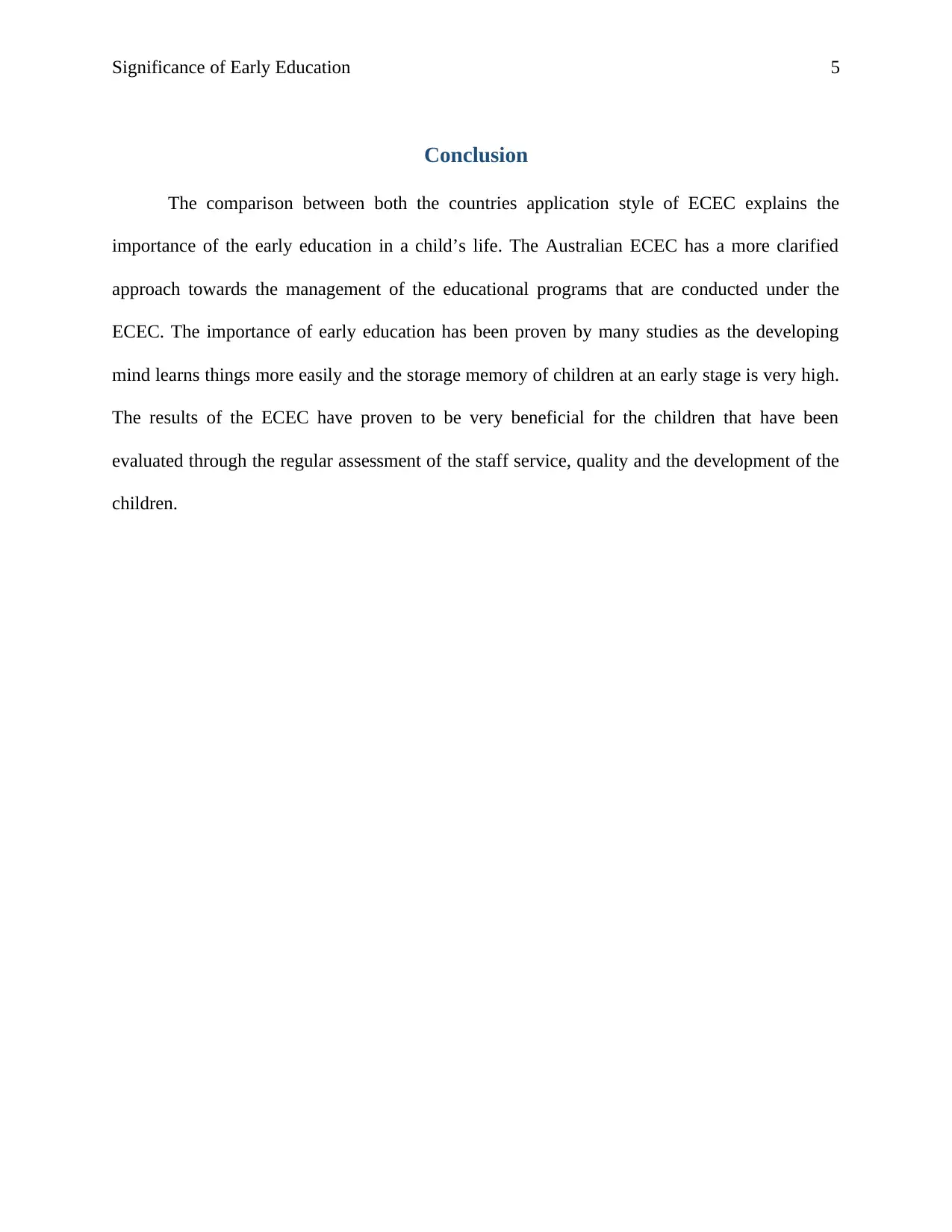
Significance of Early Education 5
Conclusion
The comparison between both the countries application style of ECEC explains the
importance of the early education in a child’s life. The Australian ECEC has a more clarified
approach towards the management of the educational programs that are conducted under the
ECEC. The importance of early education has been proven by many studies as the developing
mind learns things more easily and the storage memory of children at an early stage is very high.
The results of the ECEC have proven to be very beneficial for the children that have been
evaluated through the regular assessment of the staff service, quality and the development of the
children.
Conclusion
The comparison between both the countries application style of ECEC explains the
importance of the early education in a child’s life. The Australian ECEC has a more clarified
approach towards the management of the educational programs that are conducted under the
ECEC. The importance of early education has been proven by many studies as the developing
mind learns things more easily and the storage memory of children at an early stage is very high.
The results of the ECEC have proven to be very beneficial for the children that have been
evaluated through the regular assessment of the staff service, quality and the development of the
children.
⊘ This is a preview!⊘
Do you want full access?
Subscribe today to unlock all pages.

Trusted by 1+ million students worldwide
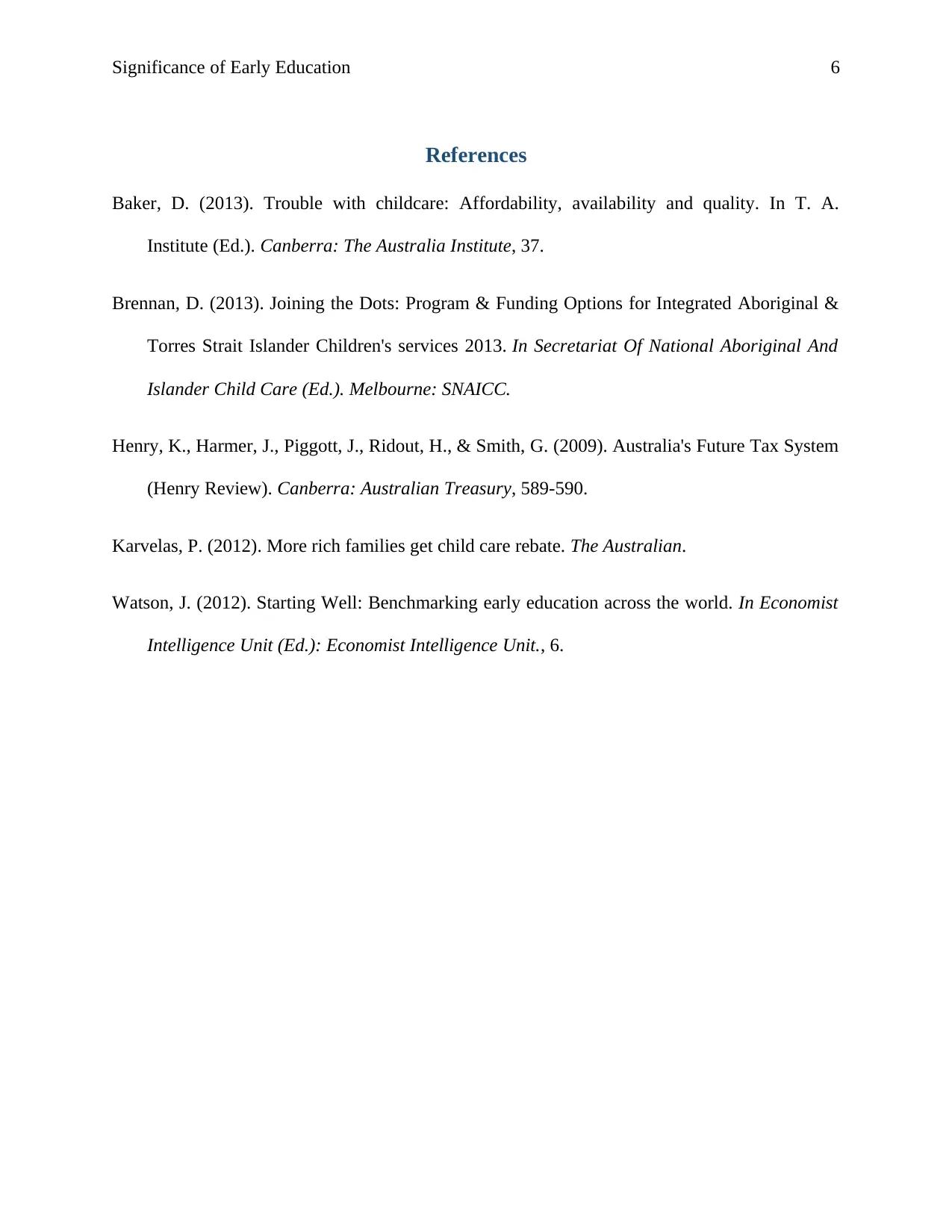
Significance of Early Education 6
References
Baker, D. (2013). Trouble with childcare: Affordability, availability and quality. In T. A.
Institute (Ed.). Canberra: The Australia Institute, 37.
Brennan, D. (2013). Joining the Dots: Program & Funding Options for Integrated Aboriginal &
Torres Strait Islander Children's services 2013. In Secretariat Of National Aboriginal And
Islander Child Care (Ed.). Melbourne: SNAICC.
Henry, K., Harmer, J., Piggott, J., Ridout, H., & Smith, G. (2009). Australia's Future Tax System
(Henry Review). Canberra: Australian Treasury, 589-590.
Karvelas, P. (2012). More rich families get child care rebate. The Australian.
Watson, J. (2012). Starting Well: Benchmarking early education across the world. In Economist
Intelligence Unit (Ed.): Economist Intelligence Unit., 6.
References
Baker, D. (2013). Trouble with childcare: Affordability, availability and quality. In T. A.
Institute (Ed.). Canberra: The Australia Institute, 37.
Brennan, D. (2013). Joining the Dots: Program & Funding Options for Integrated Aboriginal &
Torres Strait Islander Children's services 2013. In Secretariat Of National Aboriginal And
Islander Child Care (Ed.). Melbourne: SNAICC.
Henry, K., Harmer, J., Piggott, J., Ridout, H., & Smith, G. (2009). Australia's Future Tax System
(Henry Review). Canberra: Australian Treasury, 589-590.
Karvelas, P. (2012). More rich families get child care rebate. The Australian.
Watson, J. (2012). Starting Well: Benchmarking early education across the world. In Economist
Intelligence Unit (Ed.): Economist Intelligence Unit., 6.
1 out of 7
Related Documents
Your All-in-One AI-Powered Toolkit for Academic Success.
+13062052269
info@desklib.com
Available 24*7 on WhatsApp / Email
![[object Object]](/_next/static/media/star-bottom.7253800d.svg)
Unlock your academic potential
Copyright © 2020–2025 A2Z Services. All Rights Reserved. Developed and managed by ZUCOL.





